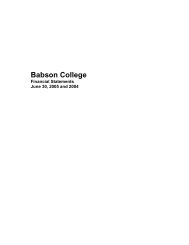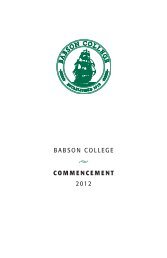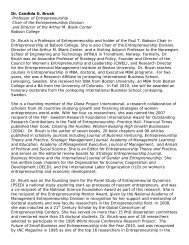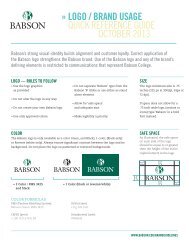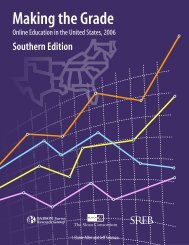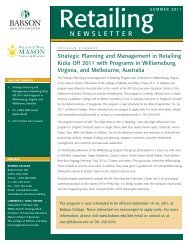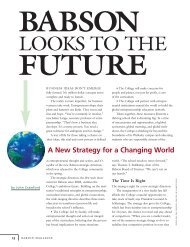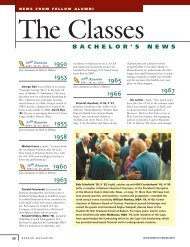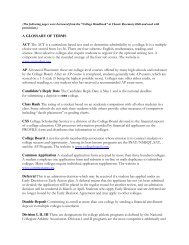michael bastian '87: - Babson College
michael bastian '87: - Babson College
michael bastian '87: - Babson College
Create successful ePaper yourself
Turn your PDF publications into a flip-book with our unique Google optimized e-Paper software.
<strong>michael</strong> <strong>bastian</strong> ‘87:<br />
founder of Michael Bastian<br />
14 <strong>Babson</strong> Magazine
They<br />
Got<br />
the<br />
Look<br />
Alumni talk of<br />
high heels, celebrities,<br />
and the business<br />
of fashion.<br />
By John Crawford<br />
Photography by<br />
Steffen Thalemann<br />
ichael Bastian ’87 remembers the first time it<br />
happened. He was in Manhattan.<br />
Sitting in a taxi at a red light, he glimpsed something<br />
familiar among the hustle and bustle on Sixth Avenue.<br />
Crossing the street, a man wore a peacoat that Bastian<br />
had designed. Never before had he spotted a stranger<br />
wearing his clothes. “That was the best,” says Bastian,<br />
the owner and designer behind Michael Bastian, a New<br />
York City-based clothing line. “I was so proud.”
Fashion<br />
Challenges<br />
Work in fashion,<br />
and you’ll confront<br />
numerous business<br />
challenges. Here are<br />
some that <strong>Babson</strong><br />
alumni face.<br />
The Entrepreneur<br />
Alison Barnard,<br />
MBA ’04<br />
owner of two Boston clothing<br />
boutiques, in-jean-ius and<br />
Twilight<br />
The Challenge<br />
Finding time to expand.<br />
“The foundation of in-jeanius<br />
was the process for fitting<br />
jeans and the one-on-one relationship<br />
between the customer<br />
and me. I was the one who researched<br />
the brands, the fits,<br />
the styles. Customers became<br />
accustomed to my knowledge<br />
and presence. Unfortunately,<br />
running a business requires you<br />
to wear many hats. Acting as the<br />
store manager with very few employees<br />
limited my ability to engage<br />
in other important business<br />
matters, therefore prohibiting the<br />
business from going beyond a certain<br />
point. I had to develop a training<br />
process and manual and invest<br />
continued on page 17<br />
any more strangers now wear<br />
Bastian’s clothes since that indelible<br />
day. His line, launched<br />
in 2006, is available in about<br />
50 stores worldwide, including Neiman Marcus<br />
and Saks Fifth Avenue. He has found fortune in an<br />
industry that can be harsh and competitive. “It’s<br />
hard for a lot of designers to get up and running,”<br />
he says. “It’s a super complicated industry.”<br />
How complicated? To reach that person in the<br />
hustle and bustle, that stranger crossing the<br />
street, fashionistas must raise money for inventory,<br />
find factories for manufacturing, navigate<br />
changing tastes, sweat the critics, court retailers,<br />
and, ultimately, connect with consumers on a<br />
personal level. Clothes are part of a person’s identity.<br />
“You’re dealing with a person’s idea of themselves,”<br />
Bastian says.<br />
Despite the challenges, the world of fashion<br />
holds an allure of glamour, fame, and, of course,<br />
money. Exactly how much money is out there for<br />
the taking depends on how the market is defined,<br />
which can be difficult. One person’s idea<br />
of fashion may be just a tube sock or T-shirt,<br />
says Kenichi Matsuno, associate professor of<br />
marketing and holder of the President’s Term<br />
Chair. However, if broadly defined as apparel<br />
for men, women, and children, the U.S. fashion<br />
market alone is valued at roughly $350 billion.<br />
A number of <strong>Babson</strong> alumni, striving for a<br />
piece of that pie, have tried their hand at fashion.<br />
Making it in the industry requires talent,<br />
hard work, and guts. A solid education doesn’t<br />
hurt either. When Bastian launched his own<br />
line, he thought about the chance he was<br />
about to take, about the headaches and hurdles<br />
lying ahead. He went for it anyway. “It’s a<br />
very <strong>Babson</strong> thing to do,” he says.<br />
Starting Out<br />
Gayatri Khanna ’97 knows what it takes. As<br />
she prepared to graduate from <strong>Babson</strong>, she<br />
watched friends land high-paying jobs. She<br />
was holding out for a fashion position. “I<br />
was very focused,” she says. “I left <strong>Babson</strong><br />
with no job.” Eventually, she worked as a buyer for<br />
Saks Fifth Avenue, and then following an entrepreneurial<br />
hankering, started an embroidery business<br />
in 2000. “I borrowed a crazy amount of money from<br />
credit cards at 22 percent interest,” Khanna says. To<br />
find customers, she prowled New York City’s fashion<br />
houses collecting business cards and then coldcalled<br />
her way through the stack, trying to ooze<br />
confidence and sound as if she were with a big company<br />
instead of just a one-person shop. “One customer<br />
became two, then three and four,” she says.<br />
Today, that business, Milaaya Embroideries, is<br />
based in Mumbai and works with some 150 fashion<br />
houses around the world. Milaaya means “to unite”<br />
in Hindi, and Khanna says that’s the business’s mission,<br />
to take Indian craftsmanship to the globe.<br />
Milaaya’s embroideries adorn a host of apparel, including<br />
dresses, jackets, blouses, shoes, and pants.<br />
Khanna also launched an eponymous brand in<br />
2006 that offers Western-style attire. She describes<br />
her clothes as classic yet edgy. “I was missing the<br />
fashion of the Western world,” says the Mumbai native,<br />
who has 190 employees working for her, with<br />
marketing offices in Paris, New York, and Milan.<br />
About 20 stores in India carry her brand, though<br />
selling Western-style clothes in such a traditionminded<br />
country can be challenging.<br />
Still, times are changing. Vogue India started three<br />
years ago, and few saris are seen anymore on the red<br />
carpet at movie premieres. Khanna remembers the<br />
first time she saw a Bollywood star wearing her<br />
clothes. “It was very exciting,” she says. “I felt great.”<br />
Reaching Customers<br />
Getting the proverbial foot in the door of the fashion<br />
industry is only a first step. Other tests await. A big<br />
one is reaching customers. Standing in the way are<br />
critics, who can pan a new collection, and retail<br />
stores, which can choose not to carry it.<br />
The Internet alters that dynamic, Bastian says. If<br />
a fashion house has a show, consumers can see the<br />
clothes immediately, despite what critics think. And<br />
online retailers have popped up offering clothes that<br />
traditional stores have passed on. “The Internet is a<br />
more direct path to your customer,” Bastian says.<br />
16 <strong>Babson</strong> Magazine www.babson.edu/magazine
Check out Bastian’s clothes, and you’ll see that he’s<br />
inspired by the “classic American style” of chino<br />
pants, oxford shirts, and V-neck sweaters, though he<br />
puts his own spin on this preppy look. Bastian likes to<br />
take perfectly designed items and make them a little<br />
ragged. “The beauty of American style is the ability to<br />
look like you didn’t think about it too much,” he says.<br />
Bastian’s first job was as an assistant buyer for<br />
Abraham & Straus, and after working for upscale<br />
brands such as Tiffany & Co., Polo Ralph Lauren,<br />
and Bergdorf Goodman, where he was men’s fashion<br />
director, he launched his own line. At first, he seemed<br />
lucky, finding an Italian partner to handle some of the<br />
difficult aspects of starting out, such as finding fabrics<br />
and factories. Unfortunately, this arrangement meant<br />
the partner owned the license to produce and distribute<br />
Bastian’s products. “I had no control over my pricing,”<br />
Bastian says. With his clothes priced too high for<br />
many potential customers, he cut ties with the partner<br />
last year. “We hope to reduce our prices by 15 to<br />
20 percent and make up any lost continued from page 16<br />
ground,” he says. “We’re taking a<br />
step back to take 10 steps forward.”<br />
One big step forward is the collections<br />
he started creating for Gant last<br />
year. The clothier reached out to Bastian<br />
to help rekindle its brand, which has<br />
fallen off the fashion radar in America.<br />
Bastian’s Gant work will include a women’s<br />
collection, a first for the designer, for<br />
this spring. “That’s being in a whole different<br />
league,” he says, for women are much<br />
more open than men to trying new looks.<br />
Point of Difference<br />
Another challenge in fashion is the clutter of the<br />
marketplace. “Ideas are a dime of dozen,” says<br />
Ruthie Davis, MBA ’93, the owner and designer of<br />
her eponymous line of shoes and handbags, which<br />
are available in about 40 stores, including Neiman<br />
in hiring good salespeople to represent<br />
the in-jean-ius brand. This enabled me to<br />
open my second store, Twilight, and plan<br />
the expansion of the in-jean-ius brand.”<br />
The Entrepreneur<br />
Patrizia Damiani, MBA ’09<br />
owner and “chief shoe officer” of Fit<br />
in Clouds, which offers foldable,<br />
portable shoes that can be carried<br />
in a purse<br />
The Challenge<br />
Spreading the word.<br />
“Without a multimillion dollar<br />
advertising budget, we rely<br />
on word of mouth and PR. To<br />
make matters worse, a national<br />
brand with deep<br />
pockets and established<br />
distribution entered the<br />
market with a similar<br />
product at a lower price<br />
continued on page 19<br />
Gayatri Khanna ‘97:<br />
founder of Milaaya<br />
Embroideries and<br />
Gayatri khanna<br />
House of Fashion<br />
Ian Pereira/GPA<br />
winter 2011 17
uthie:<br />
davis,:<br />
mba ‘93:<br />
founder of<br />
ruthie davis<br />
edu<br />
To see a slideshow of the<br />
many fashions available<br />
from <strong>Babson</strong> alumni, go to<br />
www.babson.edu/magazine.<br />
Marcus and Kitson Melrose, in some 20<br />
countries. “Some designers have gorgeous<br />
shoes, but there’s no point of difference.”<br />
That’s not a problem for Davis. Her<br />
shoes, to put it in a word, are bold.<br />
They’re full of bolts and buckles, studs<br />
and zippers. “I’m an athlete, but I’m<br />
also a girl who loves high fashion,”<br />
Davis says, so she transplants the<br />
“colors, energy, and youthfulness of<br />
a Nike” to a high-end shoe. She also<br />
takes inspiration from the sleekness of Apple products,<br />
as well as from James Bond movies. “My muse<br />
is a James Bond girl,” she says. “My shoes are for the<br />
girl on the go.” Her best-selling shoe sprouts tiny<br />
spikes. “It doubles as a weapon,” she quips.<br />
Like anyone else in fashion, Davis faces challenges.<br />
There’s the competition her small office faces<br />
from bigger labels (“I’m competing with people who<br />
have hundreds of employees.”); the upfront capital<br />
needed every season to launch a collection (“It’s not<br />
cheap.”); and the harsh what-have-you-done-forme-lately<br />
attitude of retailers (“You’re only as good<br />
as your last shoe.”). But Davis loves her work, the<br />
journey it takes her on every season, from sketching<br />
new shoes to overseeing their manufacturing in Italy.<br />
“For me, they are like my children,” she says. “Each<br />
has its own personality, its own identity.”<br />
Before starting her New York City-based brand,<br />
Davis worked at Reebok, Tommy Hilfiger, and Ugg<br />
Australia, where under her initiatives as VP of marketing<br />
and design, a sheepskin boot predominately<br />
worn in California and known as a “surfer dude<br />
brand” became an international fashion trend.<br />
A major factor in that transformation was the critical<br />
exposure offered by celebrities, who started<br />
wearing the boots after Ugg gifted them pairs.<br />
With firsthand knowledge of PR’s importance,<br />
Davis employs an agency to work with celebrities<br />
for her own brand. Many famous ladies, including<br />
Beyoncé and Lady Gaga, wear her shoes. “No one<br />
needs $950 Ruthie Davis shoes,” she says. “They buy<br />
them because Beyoncé is amazing and that’s what<br />
she’s wearing.” Of course, celebrities must like the<br />
shoes to wear them. “There are large brands that gift<br />
many pairs to celebrities, and they are never worn,” Davis says.<br />
An Established Brand<br />
Russell McKinnon ’84, of sporting apparel company Stall & Dean,<br />
also understands the influence that celebrities can wield. One day,<br />
without warning, rapper 50 Cent strolled into Stall & Dean’s New<br />
Jersey office and asked for some jackets that had caught his eye.<br />
Soon, a number of other celebrities, including hip-hop royalty<br />
Jay-Z and Eminem, began sporting the company’s clothes. “Think<br />
about that,” says Stall & Dean’s president, CEO, and owner. “They<br />
can wear whatever they want, but they’re wearing my stuff.”<br />
18 <strong>Babson</strong> Magazine www.babson.edu/magazine
Beginning as a clothing manufacturer in 1898,<br />
Stall & Dean has a long history that intertwines<br />
with legendary sports teams and players. It outfitted<br />
the original six NHL teams, for instance, and<br />
had endorsement deals with stars such as Ty Cobb<br />
and Babe Ruth. The company, headquartered in<br />
Westborough, Mass., stores some 50,000 pieces of<br />
memorabilia in a secure off-site location. “It’s a<br />
whole history of sports,” McKinnon says.<br />
McKinnon bought the company in 1996, even<br />
though, unlike his fellow alumni Bastian, Khanna,<br />
and Davis, he had no fashion experience. He was a<br />
lumber salesman and real estate investor. “The<br />
move made no sense whatsoever,” he admits. “I just<br />
go with my gut.” He found himself with a company<br />
far removed from its glory years. Stall & Dean once<br />
had 150 employees, but by the mid-1990s, it was<br />
down to 35. “It wasn’t flourishing,” he says.<br />
Trying times followed. McKinnon closed the<br />
company’s unviable factory. He sunk money into<br />
marketing but soon was running out of funds. Later,<br />
he brought on a president with fashion expertise<br />
and ended up wrestling with him for control of the<br />
business. McKinnon eventually fired him.<br />
Another threat came from the large sports apparel<br />
companies. Through the 1970s, 1980s, and<br />
russell:mckinnon ’84:<br />
owner of stall & dean<br />
1990s, those companies eroded the sports uniform<br />
sales that Stall & Dean had at the professional and<br />
college levels. By last decade, the large companies<br />
moved into the high-school uniform market, thus<br />
eating more into Stall & Dean’s business. “They<br />
flushed all the little guys away,” McKinnon says.<br />
Despite the setbacks, Stall & Dean still had<br />
life. With its long history, it owns the licenses to<br />
many old team uniforms, so the business repositioned<br />
itself. With the help of its celebrity<br />
boosters, it carved out a place in the throwback<br />
market. It sells jackets and hats of Negro<br />
League baseball teams and Ivy League colleges,<br />
among others. In the past 10 years, the<br />
company did about $150 million in retail.<br />
Staying relevant after 110-plus years<br />
selling apparel is no easy task. Competition<br />
is fierce. Tastes are fickle. For those in<br />
fashion, just making it from season to<br />
season requires mettle. “The formula<br />
changes every day,” Khanna says. Regardless,<br />
the fashion world remains<br />
enticing. Designers create beauty, after<br />
all, and their work is an intimate part<br />
of people’s lives. Think of the stranger<br />
on Sixth Avenue wearing Bastian’s<br />
peacoat. “When I see guys wearing<br />
something of mine on the street,”<br />
Bastian says, “that’s the reward.”<br />
continued from page 17<br />
point. We had to work even<br />
harder to differentiate ourselves.<br />
We leveraged group<br />
buying sites to reach a large<br />
audience. We improved our<br />
packaging, focused on customer<br />
satisfaction, and used<br />
PR to get visibility in fashion<br />
media. We geared ourselves to<br />
say, we are not selling foldable<br />
shoes, we are selling a fashionable<br />
alternative to heels. Big<br />
difference.”<br />
The Entrepreneur<br />
Keri Barrett ’07<br />
co-owner of First Date, a clothing<br />
boutique in Andover, Mass.<br />
The Challenge<br />
Choosing the right inventory.<br />
“Buying for your customer is truly<br />
an art. You must buy what your client<br />
base desires and, at the same time,<br />
you need to evaluate a product’s fit,<br />
uniqueness, quality, value, price point,<br />
and delivery timing. This all has to be<br />
done within your set budget. It’s easy to<br />
buy beautiful clothes that sell at a high<br />
price point but finding items that have a<br />
nice fit and a unique style at a lower price<br />
point is a constant challenge. We laugh<br />
when customers or friends say that it must<br />
be fun to go to trade shows and buy clothes<br />
for upcoming seasons when, actually, it can<br />
be overwhelming and exhausting.”<br />
The Entrepreneur<br />
Candice Cabe, MBA ’10<br />
owner of Day 2 Night, which offers high heel<br />
shoes with heels of variable heights<br />
The Challenge<br />
Dealing with different cultures.<br />
“We work with manufacturers in China, which<br />
can be difficult for several reasons. One factor is<br />
the obvious language barrier. I asked some of my<br />
fellow <strong>Babson</strong> classmates to help me in translating<br />
and communicating with factory representatives.<br />
Another factor that’s challenging is the culture differences.<br />
Americans tend to stick to their due dates<br />
more often than not. The Chinese folks that I’ve<br />
dealt with will tell you they can get something to you<br />
in 10 days, but it can take weeks and even months<br />
before they deliver. I’ve adjusted by demanding products<br />
be sent to me much earlier than I need them.”<br />
winter 2011 19



